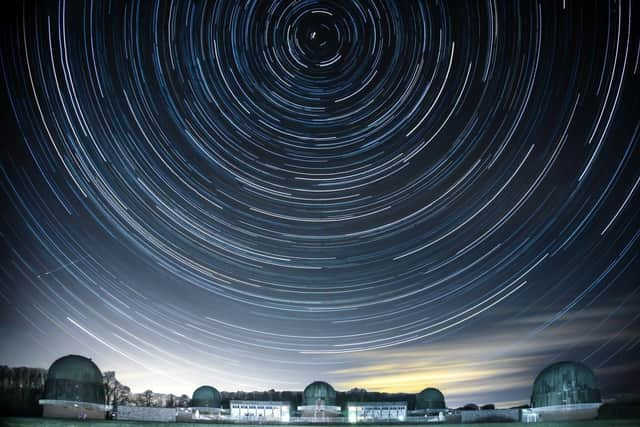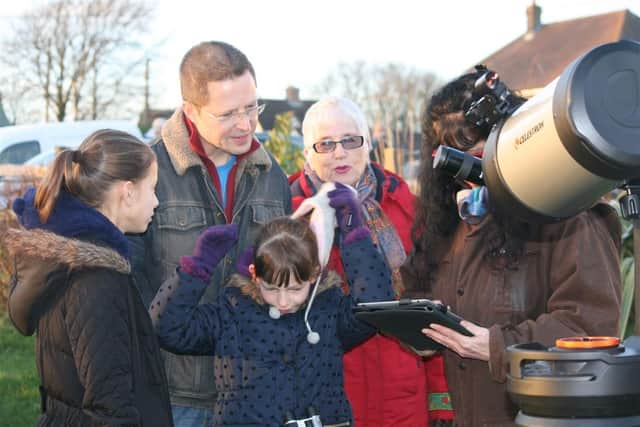Stargazing in Sussex: Tips for beginners and the best places to see the stars
and live on Freeview channel 276
Doug Edworthy, FRAS, chair of East Sussex Astronomical Society, said: “And the answer, in much of Sussex away from major population centres, is yes.”
There are a number of astronomical societies across the county.
Advertisement
Hide AdAdvertisement
Hide AdEast Sussex Astronomical Society (ESAS) was founded at the turn of the century in 2000.


Here Doug shares his tips for beginners wanting to star gaze.
Use your own eyes: On a clear night with little or no cloud get out under the stars with just your eyes, no equipment needed to start with. Give your eyes at least 30 minutes to adapt to the low light level – without looking at your phone or any other bright light in the meantime – as you look above you.
Locate easy constellations: What do you see? Lots of points of light, mainly all white. Try to pick out some of the more famous constellations: looking North you should be able to see the ‘Plough’, a pattern of stars that form part of Ursa Major, the Great Bear. Using the two stars at the side of the ‘pan’ furthest away from the ‘handle’ as a guide, imagine a line between them and follow it towards a not so bright star seemingly on its own. That’s Polaris, the North star around which all the other stars and objects in the heavens appear to rotate.
Advertisement
Hide AdAdvertisement
Hide AdIn the South in winter, you’ll see magnificent Orion with his three-starred belt and, above, the orange super-giant star Betelgeuse. Below Orion’s belt hangs a series of stars making up his sword. But one of those stars isn’t a star it’s the Orion nebula and a pair of binoculars or a small telescope will show the fuzzy shape of the star nursery where new stars are being born right now.


Find your way around with a planisphere or smartphone app: With the aid of a planisphere (a rotating card marked with the constellations) or a planetarium app on your phone you’ll be able to locate many more constellations and interesting objects. Many of the apps are free, but some require registration and small payments. These guides will show you where to find things of interest such as the Milky Way, planets, star clusters, nebulae, and galaxies.
Don’t buy a telescope, yet: Before investing in a telescope, buy some good quality astronomical binoculars. A specification of 10x50 (10 times magnification, and 50mm objective lenses) is a great compromise between weight and performance (and price!). With this type of binoculars, you’ll find so much more in the sky to see than you could with your naked eyes. A tip, find something to rest on (an upturned broom is a low-tech, low-cost solution), or invest in a monopod or tripod to keep the image stable and not wobbling. Alternatively, use a sun-lounger and lay back, resting the binoculars against your eyebrows and gripped by your hands.
If you desperately feel the need for a telescope then think carefully about the type and complexity of different makes before taking the plunge.
Advertisement
Hide AdAdvertisement
Hide AdTry ‘averted vision’: You may find nebulae and galaxies are difficult to see through your binoculars or telescope. That’s because these objects are so dim the light from them isn’t strong enough to trigger the light cells in our eyes at the point where we normally focus. These cone cells allow us to see in colour but need strong light. Surrounding them are rod cells that a far more sensitive but give us a black and white image.


Doug said: “Astronomers use a trick called ‘averted vision’ where we don’t look directly at the fuzzy object, but a little above, below or to the side of it and, lo and behold, it pops into view. Try it.”
Join an astronomy society: The best advice that a seasoned amateur astronomer can give to a beginner is to join an astronomy society. You’ll find like-minded people there who won’t care if you ask them asked daft questions, in fact they’ll be very happy to pass on their own knowledge and experience. In addition, you should be able to look through many different types of telescopes and ask questions about them which could help if you’re thinking of buying one.
When it comes to picking the best spot make sure you pick somewhere away from light pollution, usually out of town.
Advertisement
Hide AdAdvertisement
Hide AdThe South Downs National Park is a certified Dark Sky Reserve and along the South Coast from Cuckmere Haven to Birling Gap, many astro-photographers gather to take advantage of the dark skies.
Further West, the ‘core’ area of the South Downs Dark Skies stretches along the Hampshire/Sussex border and East along the downs above Midhurst and Pulborough.
In East Sussex, travel up into the High Weald and you’ll find many places where you can get away from the worst of the light pollution.
A very useful website is the CPRE’s interactive dark skies map www.nightblight.cpre.org.uk/maps/ . With this map you can zoom in on any location in the UK and gauge how dark any location is likely to be.
Doug said: “But wherever you go, safety first. If you go alone, let someone else know where you are going and what time you are expecting to be home. Make sure you are dressed for the weather conditions and have a hot drink and some energy food – you can get very cold standing around in the dark. Take a red-light torch so you can see where you are stepping and to preserve your night vision. And, whatever you do, enjoy our glorious Sussex skies.”
More information can be found at www.eastsussexas.org.uk
The South Downs Dark Skies Festival is returning in February 2022.